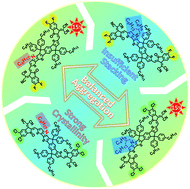Molecular engineering of acceptors to control aggregation for optimized nonfullerene solar cells†
Abstract
Dual molecular engineering of alkyl side chains and halogen accepting ends of asymmetric fused-ring acceptors has been proposed for controlling aggregation for optimized organic solar cells (OSCs). Fluorination or chlorination on end-capped groups are explored along with linear octyl (C8) or branched 2-butyl-1-octyl chain (BO) substitution on the donating core. The inherent features of the larger Cl atom and longer C–Cl bond markedly extend the backbone stacking area and thus enhance molecular aggregation, while bulky BO chain exert a heavier steric shielding effect on backbone stacking. Consequently, IPTBO-4Cl shows properly weakened intermolecular interaction for balanced molecular aggregation. IPTBO-4Cl when blended with a PM6 polymer donor delivers a highest power conversion efficiency (PCE) of 15% and a 72.6% fill factor (FF). Expectedly, fluorinated IPT-4F bearing shorter C8 chains outputs a good PCE nearing 15% with a 74.2% FF. To the best of our knowledge, the PCE of 15% is by far the highest for asymmetric FRA based OSCs. By contrast, IPT-4Cl and IPTBO-4F with either excessively strong or weak aggregation result in relatively low photovoltaic performance. Our results demonstrate controlling aggregation via delicate molecular engineering is an undeniably effective way to achieve efficient OSCs.



 Please wait while we load your content...
Please wait while we load your content...